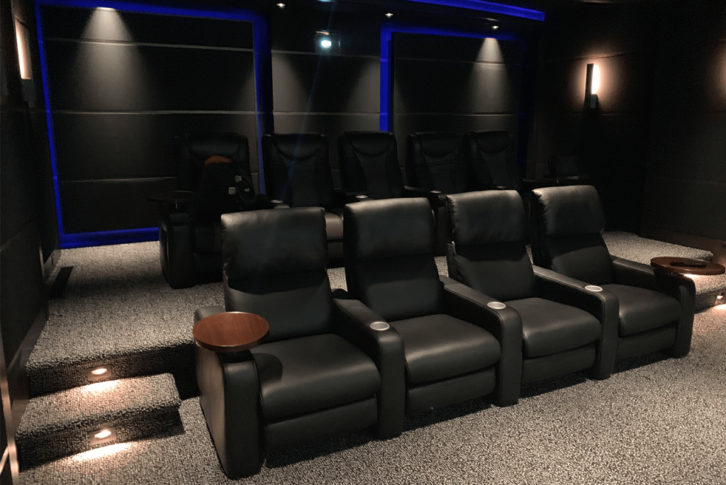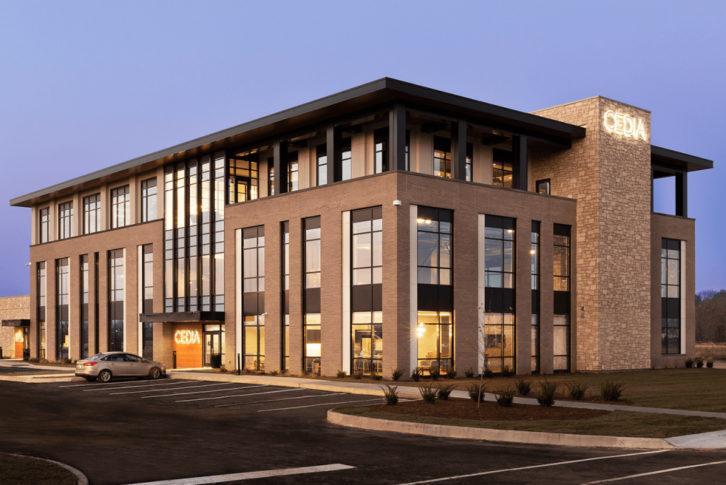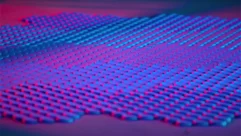 On this edition of the SVC Podcast, Contributing Editor Bennett Liles continues his talk with Dennis Erskine, president of the Erskine Group and designer of the Reference Cinema home theater located at CEDIA headquarters in Fishers, Indiana. David discusses CEDIA’s Experience Center and he explores the installation of the speakers, amplification and power system for the new theater. He also provides information on the theater system testing and AV systems in the rest of the CEDIA headquarters building.
On this edition of the SVC Podcast, Contributing Editor Bennett Liles continues his talk with Dennis Erskine, president of the Erskine Group and designer of the Reference Cinema home theater located at CEDIA headquarters in Fishers, Indiana. David discusses CEDIA’s Experience Center and he explores the installation of the speakers, amplification and power system for the new theater. He also provides information on the theater system testing and AV systems in the rest of the CEDIA headquarters building.
FOR MORE: Go to Part 1
Links:
- Trinnov Altitude32 AL32-1632 AV Processor
- Barco Loki Cinemascope P3/DCI Projector
- Kaleidescape Strato media server
- Quest Acoustical Interiors
- Crestron DM NVX
The world of high-end home theater has a wealth of different designs and features. The most advanced one of all is the new Reference Cinema home theater at CEDIA headquarters in Fishers, Indiana. The top theater designer Dennis Erskine of the Erskine Group is back to finish his story on the design and installation of the great granddaddy of them all. That’s right now on the SVC Podcast.
Dennis, thanks for being back for Part 2 on the SVC Podcast from the Erskine Group.
Thank you for having me.
We were talking about the CEDIA headquarters in Fishers, Indiana and the CEDIA Reference Cinema home theater. I wanted to get into a little more detail on what else is on display there. They mention the Experience Center and that encompasses more than just the theater so what is the Experience Center all about?
Well, the Experience Center is designed similar to what you’d find in a house. There’s a kitchen, a dining area. There’s some common spaces, a bedroom, a bathroom and, of course, a theater so that we have the ability, then, to demonstrate exactly what can be done in a residence to make the lifestyle simpler, easier and easier to manage. So there’s extensive networking in there. There’s Josh.ai, which is the artificial intelligence voice responsive system to control TVs, temperature, lights and so forth throughout the area. Kohler came in and provided the bathroom. It’s got an incredible shower in there. If there was a little more privacy I’d be tempted to try it out. But again, that can all be controlled by voice or by touchpad or whatever means you want to. But the idea was just to allow CEDIA members to bring their clients into that space and show them what is possible and prove to them yeah, it actually does work. It doesn’t have to be complicated to push the buttons and do stuff. The second purpose of it is when we bring CEDIA members in for training we can show them what is possible so that they can begin to target their training on areas to be able to accomplish the same thing in members’ homes. [Timestamp: 2:20]
Alright now in the theater you have a control point. How do you run the control cabling and everything from the control point to the speakers, the projector and to the stage area, if you have that there?
Yeah, we do have a stage area. There is a hidden, top-secret, nobody-knows-its-there HDMI input so that we can actually do presentations from a laptop in there for training purposes. But all the cabling comes from the equipment room directly into the theater and we’re using, for the HDMI runs, we’re using fiber, which will give us an upgrade path into the future, particularly when you get up to over 48 gigabytes per second for video. But yeah, that all runs from the equipment room. The equipment room itself is in the Experience Center and we put in a glass wall so members and their clients – and our manufacturing members as well – clients can see the racks and see how the racks are properly wired and labels on the wires and so forth. So it’s a combination of training and show-and-tell. [Timestamp: 3:27]
Well, that’s a great idea for CEDIA. You usually want to keep the guts of the operation sort of hidden off in some secure area but for this particular facility it would make sense to have everything right out there where people can see it. And what sort of timeline did they give you to get all of this done?
Well, for the theater we had all the time in the world because the building wasn’t even completed at the time that we were awarded the ability to do it. From our perspective, we were in there from the bare walls to the finished room, our construction team was in there for 20 days. There was five days of audio calibration and about another five days of video calibration. [Timestamp: 4:07]
That’s pretty fast for something as involved as this. When you see the pictures of it I would have thought that you’d have to work pretty fast for all of that.
Well, our advantage is we build these rooms every day of the year. So when our team goes in there they know exactly what has to be done, the sequence it has to be done in, and a lot of the stuff is prepped in a shop, strangely enough, outside of Atlanta. And a lot of the stuff is built on the C&C machine so when we arrive onsite we go in, we do our job and leave. And it happens very quickly. We’ve run into some interesting things with builders in that they want us to go in there on such-and-such a date because they’re concerned it will take us a long time and they don’t want us to delay their certificate of occupancy. And we’ve then finished the room and had to seal off the room, close off all the air ducts into the room and so forth like that because the house wasn’t finished yet. [Timestamp: 5:01]

And you’ve got a pretty sophisticated amplification scheme in there. What amplifiers did you use? Where did you locate those, in that same glass walled equipment room?
Yeah. They’re all located in there. We’re using 15 QSC Digital Cinema amplifiers for that space and also a QSC Q-SYS system for the calibration, which augments the magic that the Trinalog processor can produce. [Timestamp: 5:28]
And how did you get all of the speakers and subwoofers installed? Are they flush mounted or are some surface mounted onto the walls?
The main speakers up front behind the screen are mounted in a baffle wall. The interesting thing is the way these are done is we build the sound isolation shell and then all of the architectural elements and design elements are built inside that shell so the surround speakers and the ceiling speakers are, in fact, mounted flush to the surface of the splays or the ceiling, but there are no penetrations through the drywall, so this is all built inside the room. If you were to go in and take out all the pretty stuff and the speakers you’d have a drywalled room. [Timestamp: 6:08]
When you got all of the components in and connected, how was the system tested and calibrated? Was that Adam Pelz who did that?
That was Adam who did all the audio calibration for the room. He does that all the time for us and he’s very, very good at what he does. What he does is actually magical. We’ve worked together for longer than we’ll admit. [Timestamp: 6:29]
Well, the system testing and tweaking, that’s when it starts getting into the real fun part. I think the only part of it that would be more fun is when you first demo it and look at the reactions from people.
Yeah. There’s a great deal of satisfaction, not so much when we think we’re done but when the homeowner or the client comes in and sits down and are just totally blown away. It’s hard to describe. I’ve had clients say we don’t have golden ears, we don’t need good sound. Well, everybody has as golden ear. We know what human voices sound like. We know what drums sound like. We know what cars sound like. And when they are presented in a theater they’d better well sound like the real thing and that’s tough to do in a small room. I often say that if you were raised in the US and your favorite was chocolate and your favorite chocolate was Hershey’s, there’s absolutely no way that I can describe to you the difference between Hershey’s and Belgium chocolate. You’d have to experience it yourself. [Timestamp: 7:28]
Yeah.
And that’s tough to convey.
That especially applies to sound.
Oh, yeah. Small room acoustics is a topic that deserves a whole bunch more research. [Timestamp: 7:40]
Now in that building what other presentation spaces does CEDIA headquarters have, training rooms and things like that?
They have a very large training center and work stations. And the boot camp areas are studded walls – some drywalled, some not – so we can teach people how to properly wire and terminate and terminate wires into structured paneling. And then we have three home theater boot camp rooms that are set up so that in the training they can learn where to position the screen, hang the screen, hang the projector, calibrate the projector and then work on audio calibration, and we bring in acoustic products that they’re free to move around the room until they get it sounding like they think it should sound. And then we take them into the Reference Theater and say this is how it really ought to sound. [Timestamp: 8:29]
Oh yeah, and look at the expression on their faces when they hear that. I know that one of the most common glitches in sound systems is a power problem that produces ground hum so how did you isolate the sound system power from everything else?
In every room that we do we have a 240-volt circuit left in the equipment room and we install a Torus power unit which has a very robust isolation transformer. And what that achieves for us is we completely isolate any of the audio and video equipment from any buzzes, hums that may be interjected into the electrical system by pumps, dishwashers, hairdryers, cheap dimmers on lights and so forth so we have an absolutely clean, pristine power. Now what we had to do at CEDIA is they don’t have 240 volts coming into that building. They have 480 volts. So Torus custom built a 480-volt, 200-volt stepdown transformer for us and all of the equipment runs off of that. So we have one common ground for everything so we don’t have problems with issues from buzz and hums from outside noises. That’s all absorbed. And we’re not in a situation where we’re lacking for power when the amplifier calls for it. And with one common ground we don’t have some of the problems where you have two different grounds with different lengths and they interfere with each other. [Timestamp: 10:01]
Obviously a basic step but a very important one to get all that right before speakers, projectors and the more glamorous end of things. Sometimes people learn that the hard way.
We had a client in Texas that didn’t want to go to the expense of an isolation transformer. And he had a hum in his system and he spent a good 18 months with his electrician trying to figure out where the source was coming from and they never did solve it. He called us up and said, “I give up. Put in the isolation transformer.” We did. Buzz went away. [Timestamp: 10:31]
Even with what were supposed to be the most fancy and high-tech systems the buzz that nobody can find can drive a system operator nuts. Good you sidestepped that one right from the beginning.
Well, yeah. And part of the problem is at the end of the day we know that’s going to give us an isolated electrical system. We know, then, if there’s any buzz or hum that we’re hearing that it’s something we’ve done, not something elsewhere in the house. But if you look at it, the time and cost it would take for us or any of our dealers or an electrician to go through the house and find a source for something that’s doing that is going to cost more than to fix it in the first place. [Timestamp: 11:12]
Especially in an office building where you’ve got all kinds of potential noise producing culprits. What a mess that could lead to. Well, it’s been good of you to tell us about this one, Dennis. The CEDIA Reference Cinema home theater, a great accomplishment and I wish I could hear it for myself. We’ve been talking to Dennis Erskine of The Erskine Group, home theater experts. Thanks for getting with us.
Oh, thank you for having me. I appreciate it.
CEDIA’s Reference Cinema home theater is second to none and acoustically isolated in the middle of CEDIA headquarters. It all got done by the Erskine Group and it’s equipped with the top of the line AV gear. Get back with us next week for another AV installation adventure right here on the SVC Podcast.










